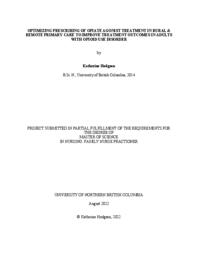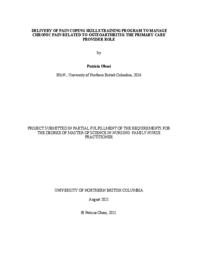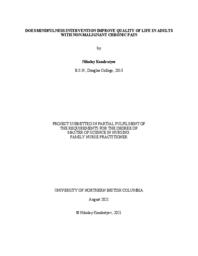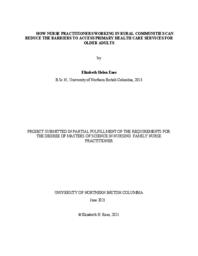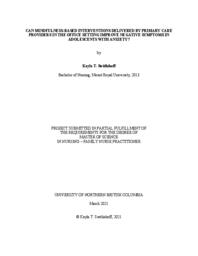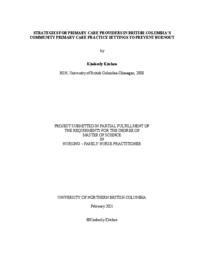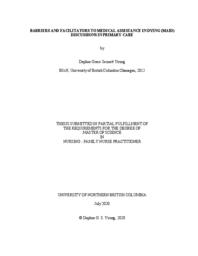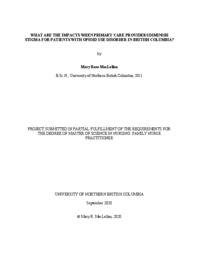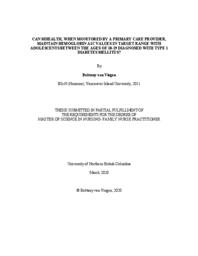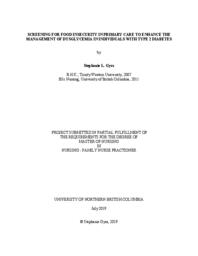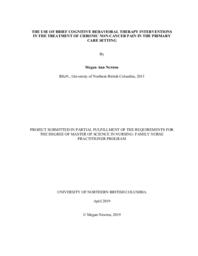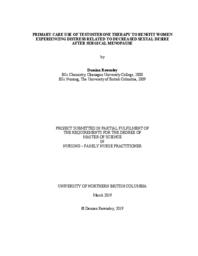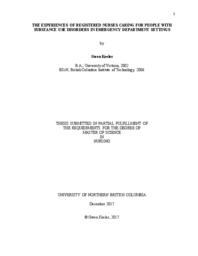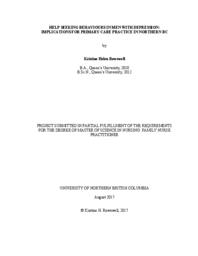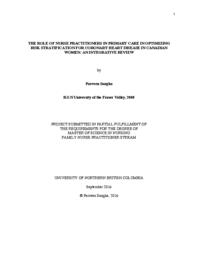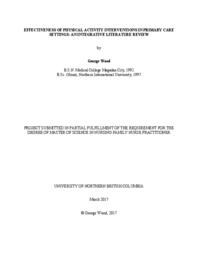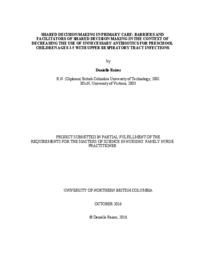Van Pelt, Linda
Person Preferred Name
Linda Van Pelt
Related Works
Content type
Digital Document
Description / Synopsis
Individuals who practice consensual non-monogamy (CNM) face a variety of challenges
in the healthcare system, from administrative barriers to negative comments to overt
discrimination to refusal of care.
It is estimated that up to 20% of adults in Canada and the United States have engaged in
CNM during their lifetime, and public awareness of CNM is increasing (Haupert et al., 2017).
However, the provision of pertinent education for healthcare providers (HCPs), as well as
research into this type of relationship, remains rudimentary at best and this has resulted in a lack
of knowledge, understanding, and general sensitivity to the healthcare needs of these individuals.
This lack of awareness, in combination with a general dearth of sexual health training for HCPs,
and a societal privileging of monogamy, most often results in negative healthcare experiences for
those individuals who practice CNM.
This review explores existing research into the healthcare experiences of adults who
practice CNM, and it offers suggestions for enabling a better understanding of CNM by HCPs.
Origin Information
Content type
Digital Document
Description / Synopsis
People in custody in Canadian provincial prisons experience disproportionately high rates
of hepatitis C virus infection. Despite national and international calls for hepatitis C elimination,
treatment access remains inconsistent within correctional settings. This integrative review
examines the barriers primary care providers face in delivering hepatitis C care to people in
custody in Canada. Following Whittemore and Knafl’s (2005) five-step framework, nine peerreviewed studies published between 2015 and 2024 were analyzed using thematic synthesis.
Studies included qualitative, quantitative, and mixed method designs, and were drawn from
Canada, Australia Austria, the United States, and international contexts. Five global themes
emerged: (1) inconsistencies in screening, treatment access, and healthcare systems across
institutions; (2) variable access to opioid agonist therapy and harm-reduction services; (3)
challenges in implementing opt-out hepatitis C screening; (4) poor linkage to care post-release;
and (5) education gaps among both providers and people in custody. Barriers were found to be
compounded by the coercive nature of correctional environments, institutional fragmentation,
and limited continuity of care. The review supports recommendations for transferring healthcare
oversight to public health authorities, expanding nurse practitioner-led care, implementing harm
reduction practices, and strengthening intersectoral collaboration to improve system level
coordination. Addressing these systemic issues is essential to meeting hepatitis C elimination
targets and improving health equity for incarcerated populations.
Origin Information
Content type
Digital Document
Description / Synopsis
This integrative review, “From Compliance to Connection: How Primary Care Providers
Can Support Diabetes Care in a Good Way,” explores how primary care providers (PCPs) can
more effectively support diabetes self-management among Indigenous adults in Canada. Type 2
Diabetes Mellitus (T2DM) disproportionately affects Indigenous communities, a disparity rooted
in colonialism, intergenerational trauma, and systemic inequities. Historically, Western medicine
has pathologized Indigenous bodies and dismissed Indigenous knowledge, reinforcing narratives
of “non-compliance” and undermining trust in care relationships. Using an integrative literature
review methodology, 11 studies were identified through CINAHL, Google Scholar, and hand
searching. These were appraised using the Critical Appraisal Skills Programme (CASP) and an
adapted Aboriginal and Torres Strait Islander Quality Appraisal Tool. Findings were analyzed
through a culturally grounded qualitative synthesis. The review revealed that diabetes is often
experienced not only as a physiological condition, but also as a relational and psychological
disruption. Barriers to effective management included biomedical dominance, lack of cultural
safety, ineffective diabetes education, and the framing of resistance as non-compliance.
However, promising practices emerged: the integration of traditional medicine, use of culturally
resonant strategies like peer support and talking circles, and the alignment of biomedical
concepts with Indigenous worldviews. This review urges PCPs to move from authority-driven
models toward relational, culturally-grounded care. It concludes with implications for practice,
education, and research, centring Indigenous-led approaches in all aspects of diabetes care.
Origin Information
Content type
Digital Document
Description / Synopsis
Cancer is a disease of increasing global prevalence, resulting in a rising need for cancer
survivorship care (CSC; World Health Organization [WHO], 2024). While definitions of CSC
vary, primary care providers (PCPs) are increasingly required to care for cancer survivors
(Nekhlyudov et al., 2017). The purpose of this integrative review is to appraise existing literature
to gain an understanding of the experiences of cancer survivors who receive CSC from a PCP.
This review was guided by the research question: for adult cancer survivors, what is the
experience of cancer survivorship care provided by a PCP? A systematic literature search was
conducted, followed by an appraisal of the selected eight studies. The findings reveal the
complexity and potential scope of CSC, revealing inconsistency and wide variability in patient
experiences of receiving CSC from a PCP. While some study participants reported positive
experiences of accessing CSC and the overall quality of their CSC from a PCP, others expressed
dissatisfaction in these areas. Some consistency in cancer survivor experience was found in the
areas of PCP knowledge levels and organization of CSC, with the overall perception being one of
inadequacy. Given the numerous benefits of improving the care of cancer survivors, and the need
to increase the role of PCPs in CSC provision, researchers, policymakers, and educators need to
take note of these patient experiences to make positive improvements to CSC.
Origin Information
Content type
Digital Document
Description / Synopsis
Opioid use disorder (OUD) is a chronic and relapsing condition that affects people across British Columbia (BC). People with OUD are at significant risk of morbidity and mortality related to unintentional toxic drug poisonings from the fentanyl-contaminated unregulated drug supply. Despite the unabating rates of toxic drug deaths in BC, evidence-based pharmacologic interventions for OUD remain underutilized especially in rural and remote areas of the province. Opiate agonist treatment (OAT) is an evidence-based pharmacologic intervention for OUD that is within primary care provider (PCP) scope of practice to prescribe. This integrated literature review was conducted to address how in rural and remote communities, PCPs can improve treatment outcomes for adults with OUD when prescribing OAT. A systematic search of six large academic databases was conducted that yielded twelve peer-reviewed articles that met inclusion criteria. Findings are discussed based on key themes from the literature that demonstrate an undisputed understanding of the efficacy of OAT among rural PCPs, however treatment outcomes among rural patients with OUD are variable due to several high-level social, regulatory, environmental and organizational challenges that are exacerbated in rural regions. Scale-up of accessible OAT in primary care is integral to improving treatment outcomes for adults with OUD and preventing toxic drug deaths in rural and remote BC communities.
Origin Information
Content type
Digital Document
Description / Synopsis
Osteoarthritis (OA) is the primary form of arthritis that affects a large portion of the Canadian population. With expected increases in OA prevalence over time, the magnitude of outcomes related to inadequate pain control will place further burdens on society and healthcare resources. Pain Coping Skills Training (PCST) is an intervention protocol derived from cognitive behavioural therapy and has traditionally been delivered by clinical psychologists to manage chronic pain related to OA. However, few providers in the primary care setting are trained in PCST. The lack of trained primary care providers creates a barrier to patient access in the community setting, which should be addressed. An integrative literature review has been conducted to identify if primary care providers, who work in primary care settings, can deliver PCST interventions to decrease pain interference and improve quality of life outcomes in adult patients diagnosed with OA. The results are discussed within the context of Canada's primary care practice. Eleven articles were reviewed using Whittemore and Knafl’s approach to the integrative literature review. The results suggest that PCST interventions are both practical and possible among providers that do not possess a background in mental health specialization. Thus, primary care providers are encouraged to obtain educational competency to deliver this effective therapy to manage the adverse psychological effects on chronic pain related to OA. This way, providers can offer a biopsychosocial approach in managing OA while also playing an essential role in improving access to PCST interventions in the primary care setting. Recommendations for facilitating the uptake of PCST interventions are discussed, and specific strategies for its use in primary care are presented.
Origin Information
Content type
Digital Document
Description / Synopsis
Chronic pain is a significant problem that negatively affects quality of life resulting in distress, disability, and inappropriate prescription of analgesics. Primary care providers need evidence for non-pharmaceutical tools, such as mindfulness-based intervention, to manage the complexities of chronic pain. The purpose of this integrative literature review is to investigate the impact mindfulness may have on the quality of life of subjects with chronic pain. A background of relevant information is presented regarding chronic pain, quality of life, and mindfulness. Thereafter, a comprehensive search revealed 14 studies in this integrative literature review. Key findings include that there is low to moderate quality evidence that mindfulness improves QOL, especially in the domains of mental well-being. Overall, mindfulness can be an effective tool for individuals that are currently on pharmacological monotherapy. The study concludes with recommendations for future research and practice.
Origin Information
Content type
Digital Document
Description / Synopsis
Due to the aging population worldwide, need to access primary health care (PHC) services is increasing. Older adults are at a heightened risk of developing chronic diseases, poor health outcomes, and increased emergency department visits. Living in rural communities also increases the risk of chronicity for older adults due to a lack of PHC resources. However, there is limited information available to provide insight into how healthcare providers can reduce barriers to access to PHC for older adults. As PHC providers, nurse practitioners are in a position to implement strategies to reduce barriers older adults in rural communities face with accessing PHC services. An integrative literature review was conducted to identify barriers nurse practitioners within rural communities can reduce to improve older adults’ access to PHC services. An analysis of the literature revealed the complexity of barriers that prevent older adults from accessing PHC services in rural communities. Environmental, systemic, and individual barriers were reviewed alongside programs and interventions relevant to reducing barriers in the findings. Findings from the literature review suggested strategies to reduce these barriers, which nurse practitioners can promote in the PHC setting. These strategies include virtual care, home visits, nurse practitioner-models of care, interdisciplinary teamwork, and role clarification. In addition to these strategies, implications for practice, limitations of the study and suggestions for future research are discussed.
Origin Information
Content type
Digital Document
Description / Synopsis
Anxiety is a mental health condition affecting adolescents with negative side effects and consequences. Primary care providers are faced with a growing number of visits related to adolescent mental health and must be comfortable in assessing and treating the negative symptoms associated with anxiety. With the potential for anxiety to begin in adolescence and worsen in adulthood, a thorough search of the literature was completed to determine ways to help adolescents manage negative symptoms associated with anxiety and improve their coping skills. Mindfulness has been gaining popularity within the mental health community and therefore was chosen as the area of focus to determine how the implementation of mindfulness-based interventions in primary care could alleviate negative symptoms associated with adolescent anxiety. Upon completing the literature review, eight studies were chosen that highlighted how various care providers effectively delivered mindfulness interventions for adolescents experiencing anxiety, primarily within school and outpatient mental health settings. These studies showed trends related to positive effects including improving adolescent anxiety and improvements in other areas of the adolescents’ lives. Additionally, it was found that it was important for primary care providers to reinforce the importance of using a supportive approach including parents or caretakers as this was shown as a protective factor. Although there were no specific studies introducing mindfulness within adolescent primary care, a list of recommendations was developed to provide evidence-based rationale towards integrating mindfulness-based interventions within primary care. By doing so, this provides a foundation for mindfulness-based interventions that primary care providers can utilize to support adolescents in managing their negative symptoms associated with anxiety.
Origin Information
Content type
Digital Document
Description / Synopsis
Primary care providers (PCPs) suffer from high rates of burnout. Burnout is the result of chronic workplace stress. Burnout can significantly impact the PCP’s personal and professional life and can lead to devastating consequences. Literature often addresses organization level strategies to improve burnout rates but there is a dearth of literature focusing specifically on PCP-directed strategies to prevent burnout. Using Whittemore and Knafl’s (2005) method for integrative literature reviews, ten articles were reviewed. Results suggest that PCPs can reduce burnout by building a strong professional community. Additionally, the results suggest that burnout may be prevented by strengthening one’s personal resources via positive emotions. Recommendations for building a strong professional community and strengthening the PCP’s personal resources are discussed and specific strategies PCPs can implement are presented.
Origin Information
Content type
Digital Document
Description / Synopsis
This integrative literature review strives to determine if the delivery of reproductive and sexual health services provided through high school-based primary care clinics can improve BC adolescent sexual and reproductive health. Adolescent sexual and reproductive health not only impacts life-long health; it also has significant societal implications. Although BC has begun to focus on adolescent health, innovative health service solutions are needed to improve adolescents’ health. Systematic search through the University of Northern British Columbia online library databases and Google scholar and the evaluation of the literature using CASP analysis tools resulted in the inclusion of 10 articles. Findings suggest school-based health clinics (SBHCs) decrease barriers that adolescents experience when accessing health services as well as public health system costs. Moreover, SBHCs are an effective mechanism to support adolescent reproductive and sexual health needs, especially in those populations with elevated levels of sexual and reproductive risk factors. However, for SBHCs to be effective, sustainable funding needs to be sourced, and barriers adolescents experience when accessing services need to be evaluated and addressed. SBHCs can complement current adolescent-friendly services to meet this unique population’s needs; however, further research is needed. More robust research on various demographics, health outcomes, and Canadian-based examination is required to strengthen SBHC implementation recommendations.
Origin Information
Content type
Digital Document
Description / Synopsis
In Canada, medical assistance in dying (MAiD) is an end of life intervention intended to offer increased control to Canadians within the dying process (Brassfield & Buchbinder, 2020). Despite the legalization of MAiD in 2016 and developments in MAiD research, many primary care providers (PCPs) reported feeling reluctant to discuss MAiD with their patients (Otte, Jung, Elger, & Bally, 2017). In Canada, PCPs are typically medical doctors (MDs) or nurse practitioners (NPs) who care for patients in outpatient, non-acute care settings (Statistics Canada, 2019). As limited research has been synthesized on barriers and facilitators of MAiD discussions within the Canadian primary care context, the purpose of this integrative literature review (ILR) was to assess what factors promoted and prevented PCPs from discussing MAiD with their patients. After identifying a research question and related keywords, six databases were searched to identify relevant studies. The initial search yielded 1,874 results, which underwent inclusion and exclusion criteria and resulted in 12 references being included in the review. After collating the data, evaluating it, and summarizing the results, facilitators and barriers that affected the discussion of MAiD between PCPs and patients were divided into intrinsic and interpersonal factors. Intrinsic factors included PCP emotions, values, beliefs, education, and training, while interpersonal factors included communication, relationship, and administrative burdens (Brooks, 2019; Brassfield & Buchbinder, 2020; Selby & Bean, 2019; Kelly & Varghese, 2006; Pasman, Willems, & Onwuteaka-Philipsen, 2013; Hagens, Onwuteaka-Philipsen, & Pasman, 2017). Based on the findings of this review, strategies to promote MAiD discussions between PCPs and patients were outlined. Recommendations included identifying and addressing values, beliefs, and emotions; developing communication skills and strategies; promoting patientii provider relationships; and mitigating administrative burdens (Kelly & Varghese, 2006; Selby & Bean, 2019; Pasman et al., 2013; Brooks, 2019). As MAiD-related research in Canada progresses through its pioneering phase, future research has been suggested to support the development of communication guides specific to MAiD as well as the evaluation of PCP approaches to MAiD discussions within the Canadian primary care setting (Selby & Bean, 2019; Brooks, 2019).
Origin Information
Content type
Digital Document
Description / Synopsis
Stigma is a complex phenomenon with a myriad of detrimental health and social impacts that are not fully studied or understood. Persistent stigma exists towards individuals who have opioid use disorder (OUD) in British Columbia. OUD is a chronic, relapsing, clinical condition that has been identified as one of the most challenging substance use disorders. For those affected, they must also endure the consequences of stigma that promote barriers to health care, health and social inequalities, diminished quality of life as well as increased morbidity and mortality. The current unremitting opioid overdose crisis in British Columbia further emphasizes the importance of eradicating stigma towards individuals who use opioids and/or suffer from OUD, as untreated OUD is fueling this multifaceted public health emergency. For these reasons, an integrative literature review has been conducted to identify how primary care providers in British Columbia can address the intersecting stigmas for individuals suffering OUD. The results are discussed within the context of primary health care in British Columbia. Whittemore and Knafl’s approach to the integrative literature review was utilized in this study to review eleven pertinent articles. The findings suggest that stigma occurs on varying levels for individuals with OUD that serve to reinforce each other and manifest as discrimination, mistrust, social distancing, minimized advocacy, unequal access to health care and suboptimal health care. Further, the findings indicated that the role of primary care providers may be instrumental in eradicating stigma in a timely manner. Recommendations for primary care providers to dismantle the stigma associated with OUD are discussed, and specific strategies for the primary care setting are presented.
Origin Information
Content type
Digital Document
Description / Synopsis
Primary care providers (PCPs), including nurse practitioners and primary care physicians, experience significant occupational stress, putting them at risk for chronic stress and burnout. Burnout rates are high amongst PCPs, and results in negative health effects that can impact the personal life of the PCP, as well as professional outcomes and patient care. Mindfulness has been shown to reduce anxiety and burnout symptoms, and improve healthcare provider well-being. Using an integrative literature review methodology outlined by Whittemore and Knafl, this paper explores if a mindfulness practice can reduce stress and burnout symptoms for PCPs. The results are discussed within the context of a primary care setting in Canada. Relevant literature was searched and a selected sample of ten primary research articles was selected for further analysis. Results suggest that mindfulness interventions are effective for reducing stress and burnout symptoms for PCPs, but access to these interventions may be a barrier to successful implementation of a mindfulness practice. In a primary care setting in Canada, PCPs are encouraged to attend mindfulness interventions and incorporate learned components into their practice, thereby increasing patient-centered care. Recommendations for reducing stress and burnout symptoms for PCPs are discussed, and specific strategies for successful implementation of mindfulness interventions are provided.
Origin Information
Content type
Digital Document
Description / Synopsis
Diabetes mellitus is an international epidemic affecting millions of individuals worldwide. In Canada, an estimated 3.4 million individuals are living with diabetes mellitus— approximately 9.3 percent of the total population (Canadian Diabetes Association, 2018). A high prevalence of diabetes mellitus comes with a substantial cost; the direct annual cost associated with diabetes mellitus is expected to reach 3.1 billion dollars by 2020 (Bilandzic & Rosella, 2017). The Canadian Pediatric Society recognizes that there are currently 33,000 children and adolescents aged 5-18 years old living with type 1 diabetes mellitus (T1DM) (as cited in the Diabetic Children’s Foundation, 2018). As children and adolescents with T1DM are in the process of developing physically and psychologically, they are at an increased risk of developing complications of diabetes that require short to long term attention and monitoring. The utilization of mobile technology to provide healthcare services is commonly referred to as mHealth. Such technology offers an opportunity to address the challenges of chronic disease management with this technology- intelligent population (Kitsiou, Paré, Jaana, & Gerber, B. 2017). As a component of the Master of Science in Nursing- Nurse Practitioner program at the University of Northern British Columbia, the following is an integrative review to answer the research question: Can mHealth, when monitored by a primary care provider, maintain hemoglobin A1c values in target range with adolescents between the ages of 10-19 diagnosed with type 1 diabetes mellitus?
Origin Information
Content type
Digital Document
Description / Synopsis
Type 2 Diabetes (DM 2) is increasingly prevalent worldwide. Its potential for debilitating long-term sequelae and subsequent burden on healthcare systems highlight the importance of adequate diabetes management. Glucose control remains central to treatment and often includes nutritional therapy, pharmacotherapy and self-management strategies. Individuals with DM 2 who experience food insecurity (FI) are at an increased risk of poorly managed diabetes. Nurse practitioners in primary care are specifically skilled at identifying patient difficulties in making, adopting and adhering to lifestyle changes, thus are ideally positioned to address barriers to chronic disease management. However, it remains unclear how FI influences DM 2 and how it is accurately identified in the primary care setting. An integrative literature review was completed to identify which strategies nurse practitioners can employ in primary care to identify and thus enhance the management of DM 2 among patients experiencing FI.
Origin Information
Content type
Digital Document
Description / Synopsis
As one of the foremost causes of healthcare resource consumption and disability among Canadian adults, chronic non-cancer pain (CNCP) requires significant attention within healthcare delivery and research. While CNCP treatment is typically guided by pharmacotherapeutics, current literature illustrates that Cognitive Behavioral Therapy (CBT) as a CNCP treatment can promote effective pain coping strategies, thereby improving pain and psychosocial outcomes. Cognitive Behavioral Therapy services are constrained, in particular due to limited access and referral to mental health professionals who provide these services. To improve access to CBT services and close gaps in CNCP care, primary care providers could offer brief CBT in their practices. Brief CBT (bCBT) delivered in primary care settings would provide active treatment for CNCP as well as interim treatment for patients awaiting referral to full-service CBT, should that service be required.
Origin Information
Content type
Digital Document
Origin Information
Content type
Digital Document
Origin Information
Content type
Digital Document
Origin Information
Content type
Digital Document
Origin Information
Content type
Digital Document
Origin Information
Content type
Digital Document
Origin Information
Content type
Digital Document
Origin Information





